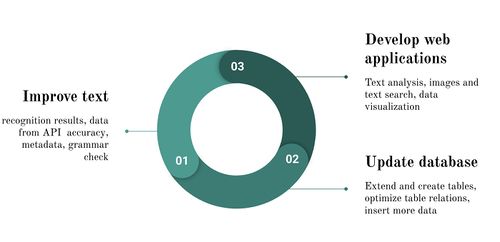Europeana: A New Spatiotemporal Search Engine: Difference between revisions
Xinyi.ding (talk | contribs) |
Xinyi.ding (talk | contribs) |
||
| Line 27: | Line 27: | ||
===1.1 Data acquisition=== | ===1.1 Data acquisition=== | ||
===1.2 Optical character recognition(OCR)=== | ===1.2 Optical character recognition(OCR)=== | ||
The reliability of OCR models depends on both the quantity and the quality of training data. So, on the one hand, quantity needs to be produced and made freely available to other scholars. On the other hand, quality needs to be properly defined, since philological traditions vary from one place to another [Duval, 2018], but also from one period to another | |||
===1.3 Grammar checker=== | ===1.3 Grammar checker=== | ||
===1.4 Text Analysis=== | ===1.4 Text Analysis=== | ||
Revision as of 09:46, 21 December 2022
Introduction and Motivation
Europeana as a container of Europe’s digital cultural heritage covers different themes like art, photography, and newspaper. As Europeana has covered diverse topics, it's difficult to balance the ways to present digital materials according to their content. The search for some specific topics needs to go through different steps, and the result of the search might also dissatisfy the user's intention. After having a deep knowledge of the structure of Europeana, we decided to create a new search engine to better present the resources according to their contents. Taking the time and scale of our group into account, we selected the theme Newspaper as the content for our engine. In order to narrow down the task further, we selected the newspaper La clef du cabinet des princes de l'Europe as our target.
La clef du cabinet des princes de l'Europe was the first magazine in Luxembourg. It appeared monthly from July 1704 to July 1794. There are 1,317 La clef du cabinet des princes de l'Europe magazines in Europeana. The page number for each magazine is between 75 to 85. In order to reduce the amount of data to a scale that can be dealt with on our laptops, we randomly selected 8,000 pages from the whole time span of the magazine.
In order to have a better presentation of the specific magazine on our engine, we mainly implement OCR, text analysis, database design, and webpage design.
OCR is the electronic or mechanical conversion of images of typed, handwritten, or printed text into machine-encoded text. This conversion from in-kind to digital format can not only be used for historical and cultural protection but also provide us access to a deep analysis of them based on the computer. In our work, we used OCR to convert the image format magazine to text and store the text in the database, which provides us with more convenience and chances to better deal with them.
For the text analysis part of our work, we used 3 methods: name entity, LDA, and n-gram to deal with the text we got.
For the presentation of the magazine, we developed a webpage to realize the search and analysis functions. The webpage aim at realizing interactivity between users, and let users have an efficient way to reach the content they'd like to get.
Deliverables
- The 8000 pages of La clef du cabinet des princes de l'Europe from July 1704 to July 1794 in image format from Europeana's website.
- The OCR results for 8000 pages in text format.
- The dataset for the text and results of text analysis based on LDA, name entity, and n-gram.
- The webpage to present the contents and analysis results for La clef du cabinet des princes de l'Europe.
- The GitHub repository contains all the codes for the whole project.
Methodologies
This project includes three main parts which are text processing, database development and web applications. At the same time, the project is conducted with a synergetic process of improving those three parts. Toolkits of this project contain Python for text processing and web applications, MySQL for database development, and FLASK for the webpage framework.
1. Text processing
1.1 Data acquisition
1.2 Optical character recognition(OCR)
The reliability of OCR models depends on both the quantity and the quality of training data. So, on the one hand, quantity needs to be produced and made freely available to other scholars. On the other hand, quality needs to be properly defined, since philological traditions vary from one place to another [Duval, 2018], but also from one period to another
1.3 Grammar checker
1.4 Text Analysis
- Named entity
- N-gram
2. Database development
2.1 Local MySQL database setup
2.2 MySQL database design
2.3 MySQL interaction
3. Webpage applications
Quality Assessment
Limitations
Project Plan and Milestones
| Date | Task | Completion |
|---|---|---|
| By Week 3 |
|
✓ |
| By Week 5 |
|
✓ |
| By Week 6 |
|
✓ |
| By Week 7 |
|
✓ |
| By Week 8 |
|
✓ |
| By Week 9 |
|
✓ |
| By Week 10 |
|
✓ |
| By Week 11 |
|
✓ |
| By Week 12 |
|
✓ |
| By Week 13 |
|
✓ |
| By Week 14 |
|
✓ |
Github Repository
https://github.com/XinyiDyee/Europeana-Search-Engine
